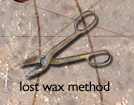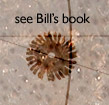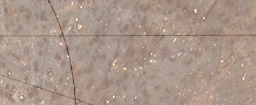





Home Bill Vielehr PO Box 19734 Boulder, CO 80308 303.443.9657 bill@vielehr.com kitty@vielehr.com |
 The Vielehr Lost Wax Method of Casting Bronze Bronze Age technology and the development of metallurgy began in approximately 3500 BC and extended through 800 BC. Metal-working developed in the Near East and China with late Neolithic peoples making and using a few metal tools and ornaments. These were mostly of copper; however, gold, silver, and lead were also known. Ancient classical Greeks inherited from Mycenae and the Late Minoan culture the knowledge of bronze casting. The Romans continued the tradition of casting artwork in bronze. Renaissance artists of the 15th and 16th century resurrected this art and craft and perfected the method of casting bronze, now called lost wax or cire perdue. •1: The Original Work of Art The artist creates an original work to be cast. This work may be in any material. Wood, clay, stone or other metals are preferred by most artists; however, I work in wax. •2: The Sprue (Gating) System Wax bars, called sprues, are attached to the work. A wax pour cup is added along with sumps and gates . This system of wax channels allows the bronze to flow to the bottom of the mold and circulate upward to the top. Once it reaches the top of the mold small holes or vents allow the bronze to displace gases or air. The system of gates and sprues are incorporated into the second mold. •3: Solid Investment The original wax work, with the sprue system added is put into a cylinder and mold material (plaster, sand & water) is poured around the wax. •4: Burn Out At this point the mold is heated in a kiln to approximately 900 degrees Fahrenheit and the wax is melted out of the mold through vent holes. This part of the process gives the name to the entire production, i.e. cire perdue or lost wax. Once the wax has evacuated the mold it is now ready to receive the molten bronze. •5: Devestment Once the molten metal has had a chance to cool and return to a solid state the work is devested of the mold. This is usually done with the aid of hammers and pneumatic tools. The gating system is then cut from the work. After removing as much of the mold as possible the sculpture is then sandblasted before it is sent to the metal shop. •6: Metal Work (Welding, Chasing, Fabrication) Large works are cast in sections and must be welded back together. Smaller works may also have plugs , i.e. sections that were removed and cast separately. The sections are welded together and the seams are chased with grinders. Once the work is welded and chased it is given a final sandblast to clean the entire surface so that it will accept the patina . •7: Patina/Caring for a Bronze Sculpture Patination is the process of applying chemicals to the surface of the bronze, which will oxidize with the metal and change its color. The patination process also enhances the ability of the sculpture to sustain the elements once it is placed out of doors. Bronze sculptures are waxed after the patina has been added. It is recommended that if a bronze sculpture is kept out of doors it should be carefully cleaned and waxed at least once a year. |
 |
 |
|
home | see art | about the artist | lost wax method download book | email the artist Site design by Stylus Creative |
 |